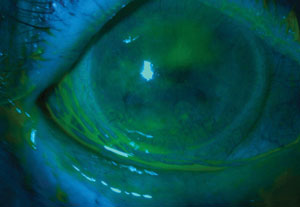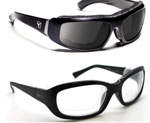  |
Ask the average person what an optometrist does, and chances are the response will include the term “glasses.” As sophisticated as our profession becomes, and as much as we continue to expand our scope of practice, spectacle frames and corrective lenses will always reside at the heart and soul of optometry.
Even today, eyewear plays a major role in how we make a living. According to a report published by the Academy for Eye Care Excellence, private practice optometrists derive about 44% of their gross income from the sale of prescription eyeglasses; this exceeds even the revenue earned from professional examination fees, which amounts to only 38%.1
But can we gain something more with the use of these devices? Could this workhorse of optometric practice pull double-duty and help to address a growing health problem in eye care; namely, ocular surface disease? Recent developments suggest it may be possible.
Moisture-Retention Eyewear
The concept of moisture-retention eyewear is not new. Publications detailing the design of moist-chamber spectacles date back nearly 70 years and explicit instruction on how to fabricate moisture chamber eyeglasses is available in the optometric literature from 20 years ago.2,3 Highly respected clinician-scientists have consistently touted the potential benefits of increased periocular humidity for alleviating the signs and symptoms of dry eye.4-6 A meta-analysis of seven prior studies even found that the use of moisture chambers or goggles provided more effective corneal protection than lubricating drops in critical care patients with the potential for exposure keratopathy.7
 | |
| Severe dry eye can result in corneal epithelial disruption. In one study, half the subjects ranked their symptoms as severe, but after one-month one month of using moisture retention eyewear, only 3% did so. |
Two of the more highly regarded and comprehensive publications in recent history regarding dry eye disease—the Delphi Panel report and the DEWS report—both recommend moisture-conserving spectacles as part of their treatment algorithms.8,9 However, this therapeutic modality seems to have always been perceived as a last resort treatment; in fact, the Delphi panel placed moisture goggles in the same category (DTS Level 4 Severity) with punctal cautery, oral cyclosporine therapy and surgical tarsorrhaphy.
Why would this be the case? We speculate that the cumbersome nature of these devices and poor cosmesis noted with the most common options, such as swim goggles or acrylic side-shields, has precluded their widespread acceptance by patients. Additionally, these devices possess no curative effect and do not address the root cause of ocular surface disorders.
Such a statement, however, is akin to suggesting that, since artificial tear preparations are merely palliative in nature, they should be used only as a last resort. Of course, we all know that these topical agents actually represent first-line therapy for virtually all patients with dry eye complaints. Could moisture-retention devices be similarly placed in the front line?
Research
Despite the apparent stigma, recent research has evaluated a new generation of moisture-retention eyewear and the results are most compelling. In an independent study, researchers evaluated 11 patients with evaporative dry eye over three months.10
 | |
| In a three-month study, patients using moisture retention glasses (7eye) were able to cut their dry eye severity by more than half. | |
 | |
| In the past, swim goggles were used as moisture chambers for dry eye. |
Inclusion criteria consisted of symptomatic dry eye complaints, a tear breakup time (TBUT) less than five seconds, Schirmer score greater than 8mm and corneal fluorescein staining present in at least one quadrant of one eye.
Individuals with punctal plugs or punctal cautery and those wearing contact lenses were excluded from the study. All subjects were prescribed 7eye (formerly Panoptyx) moisture-retention eyewear and were able to select from a variety of sizes, styles and tints to allow for an optimal fit while maximizing both appearance and function. Subjects were instructed to use the eyewear in addition to their usual treatment and were evaluated before and after the three months for dry eye severity using the Symptom Assessment in Dry Eye (SANDE) index and corneal fluorescein staining.11
At the conclusion of the study, subjects reported an overall acceptability rate of 72% (Likert score 6.48 out of 9) for the eyewear in terms of tolerability and symptom relief. The SANDE score diminished by an impressive 55% and both a clinically and statistically significant reduction in mean corneal staining was seen in all corneal quadrants. Frequency of artificial tear instillation also decreased from a mean of eight times per day to just four and a half times per day, or 44%. Tear break-up time was the only factor not impacted.
The authors concluded that moisture-retention eyewear might be a valuable adjunct in the management of evaporative dry eye and that the low profile design of the 7eye product line provided better cosmesis, increasing compliance.
That study echoes an earlier, unpublished multicenter study that followed 110 patients suffering from transient or chronic dry eye symptoms for a month. Surveys conducted before and after this trial show a distinct improvement after wearing moisture-retaining eyewear in nine specific complaints including burning, redness, itching, diminished vision, light sensitivity, discomfort in air conditioning, grittiness, dryness and excessive tearing, with a mean overall reduction of 57%. Initially, half of the subjects ranked their symptoms as severe, but at the one-month visit only 3% did so.
Thirty percent of subjects reported their overall symptoms were eliminated when wearing the moisture-retaining eyewear.12
An Old-School Approach
The most recent studies of dry eye in the United States suggest a prevalence rate of nearly 15%.13 Given the disease’s pervasive nature—growing ever more common with the aging of our population—it seems inappropriate that a noninvasive, potentially beneficial treatment option, such as moisture-retention eyewear, is relegated to such an obscure and limited status. If the studies are correct, this treatment modality can alleviate symptomatic irritation in dry eye patients by 50% or more.
Given our profession’s historical expertise with the fabrication, handling and dispensing of corrective eyewear, this approach to dry eye seems like a natural fit.
Perhaps the time has come to reexamine the benefits of moisture-retention eyewear for the adjunctive therapy of dry eye disease. Sometimes, an old-school approach is the best way to tackle a new-age problem.
Dr. Kabat is Clinical Care Consultant at TearWell Advanced Dry Eye Treatment Center in Memphis, Tenn. Neither he nor Dr. Sowka has any direct financial interest in the products mentioned in this article.
1. Profile of Independent Practice Optometry. Academy for Eye Care Excellence. Accessed: February 13, 2015. Available at: www.myalcon.com/docs/Profile_Private_Practice_Optometry.pdf.2. Hallett JW, Pittler S. Individually made acrylic moist-chamber spectacles and pinhole glasses. Am J Ophthalmol. 1946 Jun;29:725-8.
3. Hart DE, Simko M, Harris E. How to produce moisture chamber eyeglasses for the dry eye patient. J Am Optom Assoc. 1994 Jul;65(7):517-22.
4. Tsubota K. The effect of wearing spectacles on the humidity of the eye. Am J Ophthalmol. 1989 Jul 15;108(1):92-3.
5.Korb DR, Greiner JV, Glonek T, et al. Effect of periocular humidity on the tear film lipid layer. Cornea. 1996 Mar;15(2):129-34.
6. Korb DR, Blackie CA. Using goggles to increase periocular humidity and reduce dry eye symptoms. Eye Contact Lens. 2013 Jul;39(4):273-6.
7. Zhou Y, Liu J, Cui Y, et al. Moisture chamber versus lubrication for corneal protection in critically ill patients: a meta-analysis. Cornea. 2014 Nov;33(11):1179-85.
8. Dysfunctional tear syndrome study group. Dysfunctional tear syndrome: a Delphi approach to treatment recommendations. Cornea. 2006 Sep;25(8):900-7.
9. Management and therapy of dry eye disease: report of the Management and Therapy Subcommittee of the International Dry Eye WorkShop (2007). Ocul Surf. 2007 Apr;5(2):163-78.
10. Waduthantri S, Tan CH, Fong YW, Tong L. Specialized Moisture Retention Eyewear for Evaporative Dry Eye. Curr Eye Res. 2014 Jun 30:1-6. [Epub ahead of print].
11. Schaumberg DA, Gulati A, Mathers WD, et al. Development and validation of a short global dry eye symptom index. Ocul Surf. 2007 Jan;5(1):50-7.
12. Research Digest: Panoptx Eye Wear Shown to Relieve Dry-Eye Symptoms. Ophthalmology Management, May 1, 2004. Accessed: February 13, 2015. Available at: www.ophthalmologymanagement.com/articleviewer.aspx?articleid=86091.
13. Paulsen AJ, Cruickshanks KJ, Fischer ME, et al. Dry eye in the beaver dam offspring study: prevalence, risk factors, and health-related quality of life. Am J Ophthalmol. 2014 Apr;157(4):799-806.

